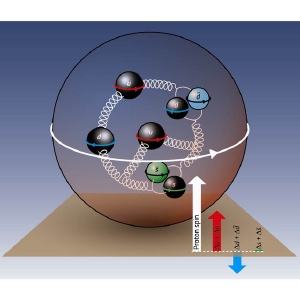Nov 14 2008
Scientists have acquired more clues in the mystery of how the spin, or intrinsic angular momentum of a nucleon (proton or neutron), results from its constituent parts, quarks and gluons. Marco Stratmann at RIKEN's Nishina Center for Accelerator-Based Science in Wako and co-workers* have used new scattering data to determine that the contribution from gluons is likely to be small.
 A proton made from two 'up' quarks (red), a 'down' quark (blue) a down quark–antiquark pair and a 'strange' quark–antiquark pair (green). The arrows on the bottom right show that the constituent spins do not add up to the spin of the proton. Now it seems that the contribution from gluons (curly lines) is also too small to make up the difference.
A proton made from two 'up' quarks (red), a 'down' quark (blue) a down quark–antiquark pair and a 'strange' quark–antiquark pair (green). The arrows on the bottom right show that the constituent spins do not add up to the spin of the proton. Now it seems that the contribution from gluons (curly lines) is also too small to make up the difference.
Until about 20 years ago, it was assumed that the nucleon spin came about mainly from the sum of spins of its component quarks and antiquarks. This theory was discredited when scientists in the European Muon Collaboration at CERN, Switzerland, performed experiments scattering muons off nucleons.
“The result was very much off the theoretical expectation and has, ever since, been dubbed the ‘spin surprise’ or even ‘spin crisis’,” says Stratmann. “Quarks were shown to contribute only very little to the spin of the proton. This triggered a flurry of theoretical activity and motivated further experimental studies.”
RIKEN scientists have recently been involved in experiments at the Relativistic Heavy Ion Collider (RHIC) at Brookhaven National Laboratory in the USA, with the aim of determining whether the ‘missing’ nucleon spin is provided by the gluon spin. If the gluon spin contribution is small, there must be a role for the orbital angular momenta of both quarks and gluons.
Now Stratmann and co-workers have presented the first theoretical analysis that includes data from the RHIC. Their work also considers data from past experiments in deep inelastic scattering (DIS), the most basic type of scattering that provided the first evidence that quarks exist, and semi-inclusive deep inelastic scattering (SIDIS), which provides separate information on quarks and antiquarks.
The researchers determined the probability density functions of quarks and gluons and used a complicated optimization procedure to fit the functions to the data as well as possible. Their results suggest that the gluons have relatively small spin polarization, and so do not account for the spin of the nucleon.
“The spin structure of polarized nucleons is still poorly known despite the recent advances in both theory and experiment,” says Stratmann, “but experiments will continue to provide data, in particular the two RHIC experiments STAR and PHENIX. Soon the RHIC will produce the first data with two identified particles in the detector which will allow us to map the gluon polarization as a function of the gluon's momentum very precisely, and uncertainties will hopefully shrink by a factor of two or more.”
- De Florian, D., Sassot, R., Stratmann, M. & Vogelsang, W. Global analysis of helicity parton densities and their uncertainties. Physical Review Letters 101, 072001 (2008).